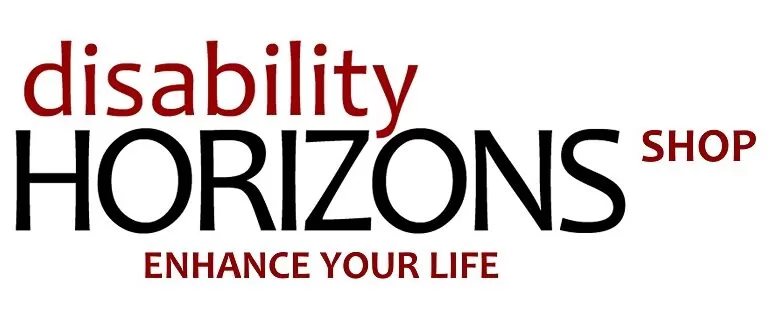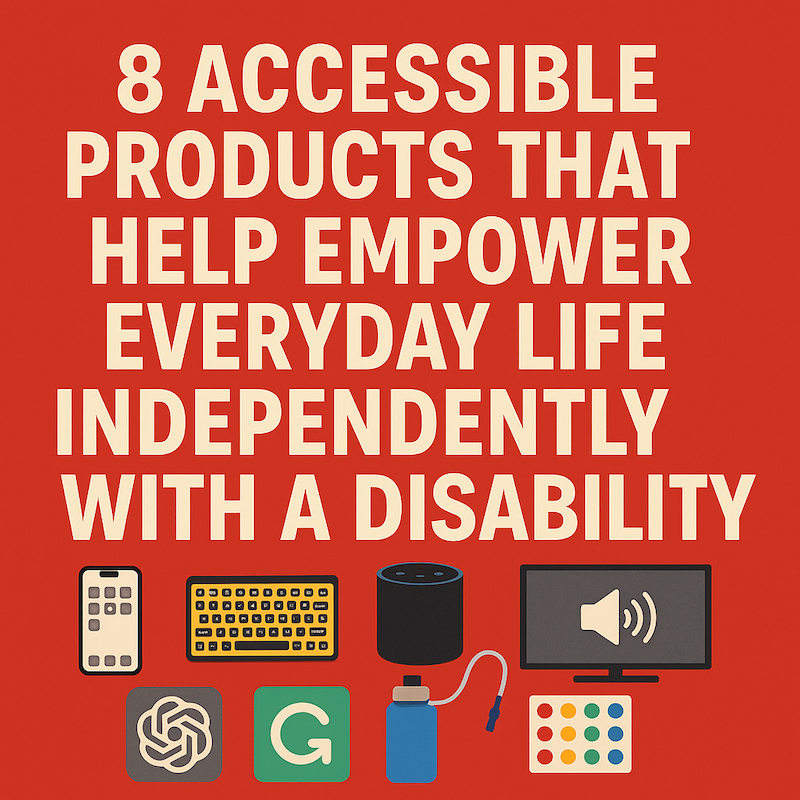Freelance journalist Emma Purcell, who lives with cerebral palsy and is registered blind, shares her personal recommendations of accessible products that have genuinely transformed her daily life. With lived experience and a passion for inclusive technology, Emma highlights eight tools that support her independence, enhance productivity, and make everyday activities more manageable and enjoyable.
1. Apple devices – powerful built-in accessibility features for blind and visually impaired users
As someone with sight loss, I admit I was rather slow to join the Apple family, but I’m so glad I did. I started with an iPhone, then an iPad and eventually a MacBook Air. A majority of my day I spend on my MacBook doing my work, checking emails, and browsing the Internet. My iPad is mostly used for when doing video calls and watching TV in bed. I mostly use my phone for the generic phone and texting, but then when out and about, I can still do things like check emails, browse the Internet and listen to music.
What makes Apple devices so amazing is the countless number of accessibility features to tailor to every impairment. These are just some of the accessibility features I use to on my Apple devices:
- VoiceOver – A screen reader that speaks aloud everything on the screen, allowing blind and visually impaired users to navigate using gestures.
- Speech Selection – Reads selected text aloud with adjustable voices and speeds, ideal for reading articles, emails or documents.
- Zoom – A built-in screen magnifier that enlarges parts of the display to make text and visuals easier to see.
- Magnifier – Turns the camera into a digital magnifying glass, perfect for reading small print or seeing distant objects.
- Larger Text – Increases the font size across system apps like Messages, Mail, and Settings for better readability.
- Smart Invert Colours – Reverses display colours without affecting media like images or videos, reducing screen glare and improving contrast.
- Assistive Touch – Provides an on-screen menu for common gestures and actions, ideal for those with limited hand mobility.
- Dictation – Converts spoken words into text, making it easier to write emails, notes, or messages hands-free.
- Sticky Keys – Allows users to press keyboard shortcuts one key at a time rather than simultaneously, supporting those with motor challenges.
- Siri – Apple’s voice assistant that can perform tasks, answer questions, send messages and more, all through voice commands.
• Speaker Phone – Enables hands-free calls with audio played through the device’s loudspeaker, useful for clearer communication. - Auto Answer Calls (when expecting an important phone call) – Automatically picks up incoming calls after a set time, ideal for users with limited dexterity or quick response ability.
You can find out more details about how are use my Apple devices by visiting my blog posts 10 accessibility features on iPhone & 10 accessibility features on MacBook Air.
2. Bluetooth keyboard – large print keyboard for easier typing with visual or physical impairments
When using my MacBook Air, I use a large print keyboard which has black text on a yellow background. This accessible device, which I purchased from RNIB, can be connected via Bluetooth to any Apple device, but I mostly use it with my MacBook, as that is the device I use most for writing, and I’m happy to use the touchscreen keyboard on my iPad and iPhone.
The keyboard can come in laptop-style or desktop-style. I prefer the laptop style as it’s more compact and easy for me to reach, being one-handed. There is also the option of white text on a black background, depending on people’s colour preferences. In addition, there is also the cheaper alternative option of having keyboard stickers that you can stick to your original keyboard.
3. Amazon Echo – hands-free smart home control for disabled and visually impaired people
I began using Amazon Echoes about eight years ago, and now I have several Echo Dots around the house to use for so many different activities and tasks. Many features I use include:
- Controlling smart devices such as lights, sockets, internal blinds and heating
- Using it as a dictionary, thesaurus and calculator
- Clock, reminders, alarms and timers
- Use the drop-in feature to talk to other devices in the home and the Ring doorbell
- Playing music, radio, news briefings, podcasts and audiobooks
- Play games and quizzes
The Echo can also be used for smart lights options. With voice commands or mobile apps, you can adjust brightness, colour, and timing schedules without needing to reach for switches. This makes it super easy (if you have limited mobility or visual impairments), to create the right atmosphere in any room.
Find out more about the ways I use my Amazon Echo by visiting my blog, 5 accessible Alexa skills you may not have considered & 5 recommended Alexa game skills to keep your brain active and entertained.
4. Audio description and voice guide – accessible smart TV features for blind and visually impaired viewers
For those of us with sight loss, we must have equal access to television programmes, films and streaming services. Audio description and voice guide to navigate TV menus is such a vital tool for people who are blind and visually impaired, so that they can enjoy all the same experiences as sighted people across the TV and film industries.
Audio description gives additional information as to what is happening on screen between the dialogue. This can be things like body language, facial expressions, landscapes, fight scenes, romantic scenes, text and images, plus much more.
Voice guide is an accessibility feature on most smart TVs that will read aloud the text on the TV menu, similar to VoiceOver on Apple devices. This allows blind and visually impaired people the ability to browse a TV menu independently to find the next bingeable box set or latest blockbuster movie.
Learn more by browsing my audio description content, and check out my blog, Samsung Smart TV accessibility review.
5. ChatGPT – AI-powered assistance for content creation, accessibility and image descriptions
I will be honest, I was quite sceptical of using AI tools like ChatGPT, but over the past year, I found it to be such an incredible tool for so many tasks. The most valuable tool is having the ability to describe images to me so I can identify images, but also create all text images that go on our website at Crip Life™. I’m also benefiting from being able to create images for our website and social media channels just by giving a brief description of what I’d like in the image.
(Editor’s note: If you have a paid plan, our Shop Manager, Duncan, created a ‘gpt’ that writes image descriptions – ‘alt text’ to visual impairment best practice guidelines, it will also create captions for images too. )
I’m also using it to help edit content and suggest things like headings, subheadings and keywords to improve article optimisation. It is also great for researching through longer documents and picking out the relevant information. Additionally, I find it useful when it can provide instructions on how to resolve a technical issue, whether it be with web development, a device issue or even accessibility support.
Find out more about the benefits of ChatGPT by visiting my article 5 Ways ChatGPT Can Support Disabled People.
6. Grammarly – easy proofreading and grammar checking for accessible writing support
Grammarly is a great tool for spellcheck, grammar and proofreading written work. Although I feel I have very good writing skills and don’t have much trouble with spelling and grammar, I still find this a useful tool for speedy proofreading of typos and errors and giving me some suggestions to improve the content that I may not have considered.
This is ideal for any type of writing, whether it’s writing articles, social media posts, emails, letters, or even just a brief WhatsApp chat.
My only criticism with it is that it doesn’t like adverbs such as “really”, “actually” or “personally”. Also, it doesn’t like times without a space between the digits and the am or pm (e.g 12:45pm). It may suggest other changes that you might think aren’t suitable or don’t make sense. In those instances, you can ignore the change by pressing “Dismiss”.
7. Hydrant water bottle – hands-free drinking aid with bite valve for disabled users
I have to say this Hydrant water bottle is such an incredible mobility aid and the best accessible product that I’ve ever bought on the Disability Horizons Shop.
The bottle comes in 750ml or 1000ml sizes, and it has a long flexible tube that can be clipped onto clothing and has a bite valve at the end of the tube for easy access to drink. This keeps me more hydrated as I can simply bite the valve and then be hands-free to continue my work or other activities on the go.
8. Touch dot stickers – tactile markers for identifying household devices and controls
Available on the RNIB Shop, these colourful tactile stickers are ideal for identifying equipment and accessing fiddly buttons on devices. Over the years, I’ve used them for a variety of places, including fan controls, headphones, ovens, washing machines and my iPad home button – just to name a few.
Why accessible products are essential for independence and inclusion
Accessible products aren’t just helpful add-ons — for many disabled people, they’re essential tools for independence, empowerment, and inclusion. Whether it’s voice technology, adaptive hardware, or clever low-tech solutions, these products reflect just how far inclusive design has come. By sharing her personal experiences, Emma hopes to inspire others to explore accessible options that can make life not only easier but also more fulfilling.
Want to learn more? Dive deeper into Emma’s personal experiences and tips by checking out her work at Crip Life™ and her blog Rock For Disability.

